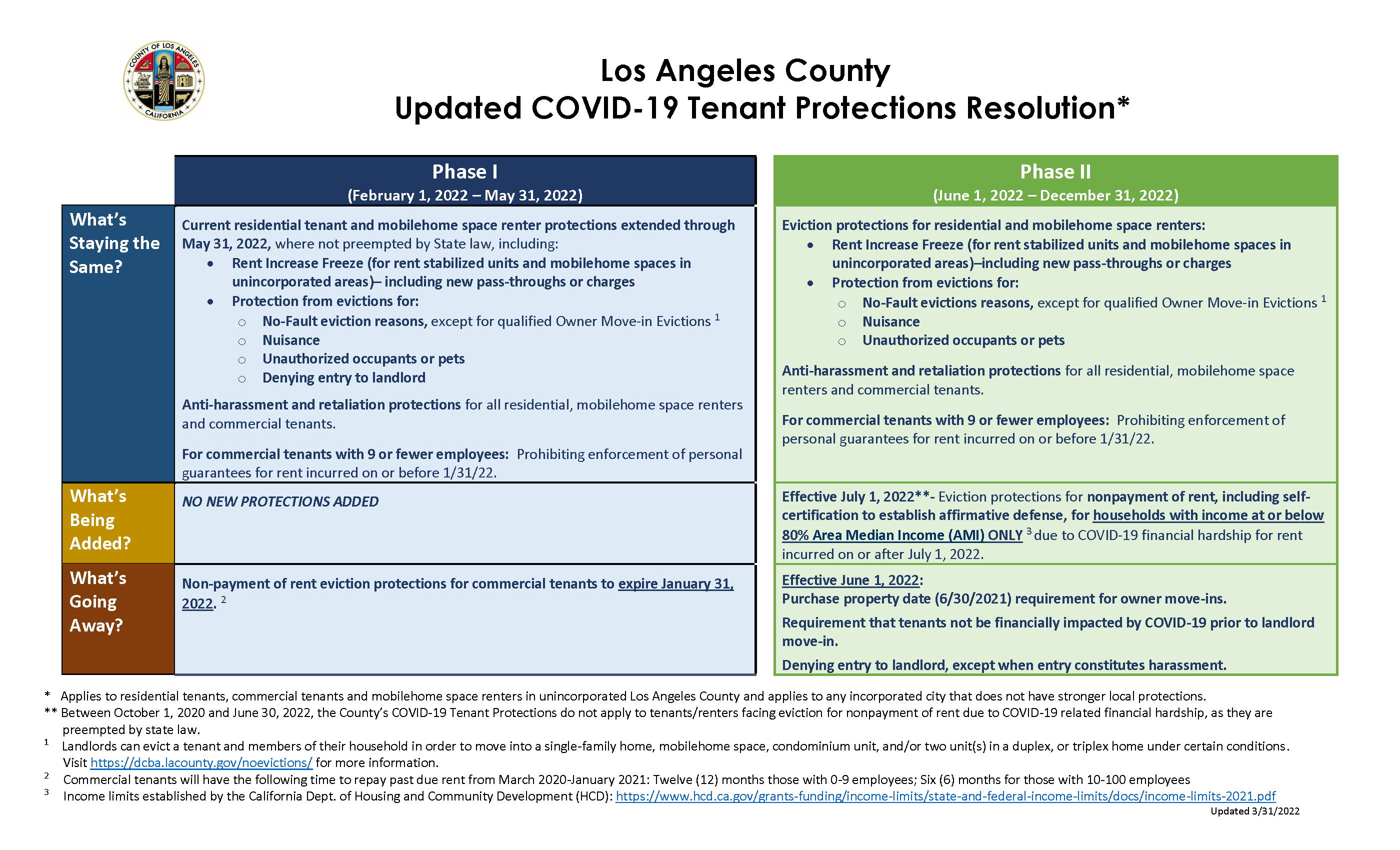We sat down again with Oliver John Baptiste from the Apartment Association of California Southern Cities to ask about the latest landlord and apartment owner concerns in Long Beach, California. The most significant topics we’ll cover are non-payment of rent and the end of LA County’s pandemic-era eviction moratorium.
Low-Income Tenants Who Can’t Pay Rent are Protected from Eviction
From now until December 31, 2022, we are under Phase II of the COVID-19 Tenant Protections Resolution. During this phase, low-income households in LA County will be protected from eviction if they cannot pay rent.
To qualify for this eviction protection, the tenant must meet two requirements:
1. Their total household income must not exceed 80% of the Area Median Income (AMI).
If a tenant’s income is below the income limits stated below, they are not eligible for eviction protection.
Income Limits For Household Sizes
| Household Size | 80% AMI |
|---|---|
| 1 | $66,750 |
| 2 | $76,250 |
| 3 | $85,800 |
| 4 | $93,500 |
| 5 | $102,950 |
| 6 | $110,550 |
| 7 | $118,200 |
| 8 | $125,800 |
2. Tenants must notify their landlord that they cannot pay rent within 7 days of the due date.
If rent is due on the first of the month, tenants have until the seventh of the month to reach out to their landlords that they cannot pay rent. This can be done either through a phone call, email, mail, or text message.
For proper notice, tenants can download the official template notice in ENGLISH or SPANISH and send it to their landlords.
IF the tenant fails to communicate or send notice to their landlords within these 7 days, then the landlord can issue a standard 3-Day Notice to Pay or Quit.
IF the tenant sends a notice to their landlords within these 7 days, then the tenant is protected from eviction, and the rent is deferred until 2023.
Important note: LA County’s protection does not cancel or stop rent from being owed or stop the accumulation of rent that is owed. Tenants are still obligated to pay their rent when they can or negotiate a payment plan with their landlord during and after the end of the eviction moratorium.
For apartment owners, this is a sense of relief when it comes to taking back control and ownership of their property for non-payment of rent. During the COVID-19 pandemic, this was not entirely possible, and many landlords have been forced to sell their properties or risk foreclosure because of their loss of income from being unable to evict tenants who have accumulated unpaid rent.
Eviction Cases in Los Angeles County are on the Rise
According to Oliver John Baptiste, attorneys in LA County are experiencing the heaviest amount of eviction cases in their entire careers. Not only are these attorneys handling massive eviction cases, but they are also having a considerable level of success for their clients, who are landlords and apartment owners.
With the lifting of the LA County COVID-19 eviction moratorium, evictions are expected to rise significantly in 2023. It is still unknown how this will impact the overall multifamily real estate market in Southern California.
Details on the Current Phase of the LA County Eviction Moratorium
These are the details of Phase II of the Los Angeles County Tenant Protections Resolution that will be in effect from now until December 31, 2022.

Landlords may still not evict a tenant for nuisance, unauthorized occupants or pets, and no-fault evictions.
Changes to No-Fault Evictions
A landlord or a qualifying member may move into the rental property (single-family home, mobile home, condo, duplex, or triplex) if they meet the following criteria:
- The Landlord or Landlords qualifying family member must physically reside at the property for at least thirty-six (36) consecutive months;
- The Landlord or Landlords qualifying family member must be similarly situated to the Tenant currently occupying home;
- The Landlord must provide at least sixty (60) days’ notice to Tenant
- The Landlord must pay tenant relocation assistance as required by the County’s Rent Stabilization Ordinance or the incorporated city’s applicable ordinance or regulation.
Please note that effective June 1, 2022, the property purchase date (June 30, 2021) and the requirement for tenants impacted by COVID-19 for Owner Move-Ins are lifted under Phase II (June 1, 2022- December 31, 2022) of the COVID-19 Tenant Protections Resolution.
Non-Payment of Rent
The protections are only limited to households with income at or below 80% of the Area Median Income, but tenants can still self-certify their income level and do not need to provide proof to the landlord.
| Household Size | 1 | 2 | 3 | 4 | 5 | 6 |
| 80% AMI Limit | $66,750 | $76,250 | $85,800 | $93,500 | $102,950 | $110,550 |
Denial of Landlord Entry
Landlords now have the ability to evict if a tenant denies the landlord lawful entry into the rental property.
Can an Apartment Owner Evict a Tenant Because of a Substantial Remodel or Renovation?
Under the current LA County eviction moratorium and Tenant Protections Resolution, this falls under a no-fault eviction and is not allowed until the end of 2022. Starting 2023, landlords will be required to follow their own city’s guidelines. Certain cities will have their own unique substantial remodel ordinances or will follow state-approved guidelines.
Can a Landlord Evict a Tenant to Move into an Owner-Occupied Unit?
A landlord or any qualifying family member can move into a residential property (single-family home, mobile home space, condominium unit, duplex, or triplex) if the property was purchased on or before June 30, 2021, and if they meet the following criteria:
- The Landlord or Landlords qualifying family member must physically reside at the property for at least thirty-six (36) consecutive months;
- The Tenants of the unit must be current on rent payments and not have been impacted by COVID-19;
- The Landlord or Landlords qualifying family member must be similarly situated to the Tenant currently occupying the home;
- The Landlord must provide at least sixty (60) days’ notice to Tenant
- The Landlord must pay tenant relocation assistance as required by the County’s Rent Stabilization Ordinance or the incorporated city’s applicable ordinance or regulation.
Please note that the property purchase date (June 30, 2021) and the requirement for tenants impacted by COVID-19 for Owner Move-Ins are lifted under Phase II (June 1, 2022- December 31, 2022) of the COVID-19 Tenant Protections Resolution.
If a landlord decides to evict a tenant to occupy a unit, it could cost them between $8,000-$13,000 in relocation fees. According to Oliver John Baptiste, many apartment owners are waiting until the end of the eviction moratorium to exercise this option.
Landlords will need to use the following forms as part of the process to evict the tenant(s) and provide notice to the Department of Consumer and Business Affairs:
Even if the LA County Eviction Moratorium and Tenant Protections End, There May Still be Ongoing Tenant Protections at a City Level
Although at the county level, the Tenant Protections Resolution is set to end this year, more California cities are enacting their own rent control to protect tenants.
For example, the city of Bell Gardens voted to advance a rent control plan that limits annual increases to no more than 4%. The city of Pomona also adopted its own rent control ordinance last August.
According to Oliver John Baptiste, more and more cities in Southern California are adopting their own form of tenant protections and rent control so we can expect more cities in Los Angeles County to follow suit as the end of 2022 approaches.
Landlords in the City of Los Angeles are Not Allowed to Increase Rents Until 2023
Los Angeles rent control laws generally apply only to rent-stabilized units built before October 1st of 1978. Usually, landlords in California are generally allowed to increase rents up to 10% annually, according to the state rent control law (AB-1482).
But Los Angeles Mayor Eric Garcetti’s emergency order changed that, and landlords have been blocked from any rent increases until 2023. Landlords remain able to charge whatever they want for apartments once a tenant vacates.
This rent freeze does not include single-family homes, condos, and townhouses.
Please note that every city in California may have its own rent increase limitations and rent control ordinances. Read more about it here.
Important Links and Resources for Tenants and Landlords:
- Apartment Association of California Southern Cities
- Los Angeles County Eviction Protection Information
- Housing is Key California Rent Relief Program Application
- Long Beach Emergency Rental Assistance Program
- Landlord Protection Information on Rental Assistance and Mortgage Forbearance
- Murchison Updates from the City of Long Beach
- Substantial Remodel Ban Updates from City of Long Beach







